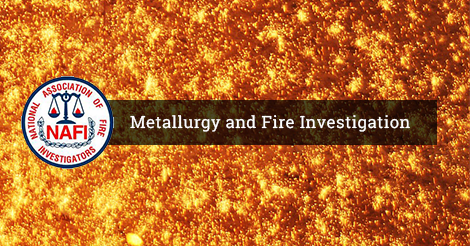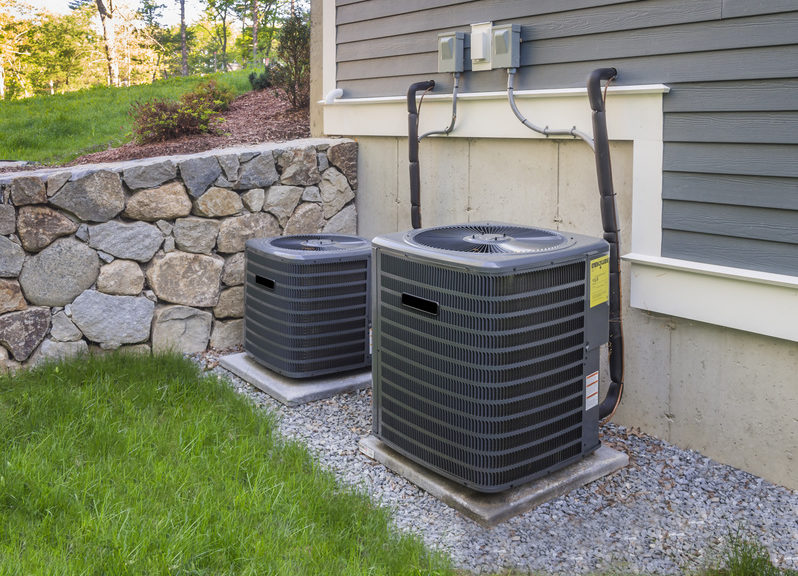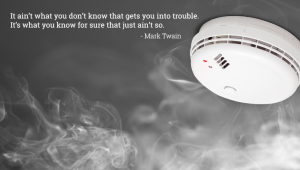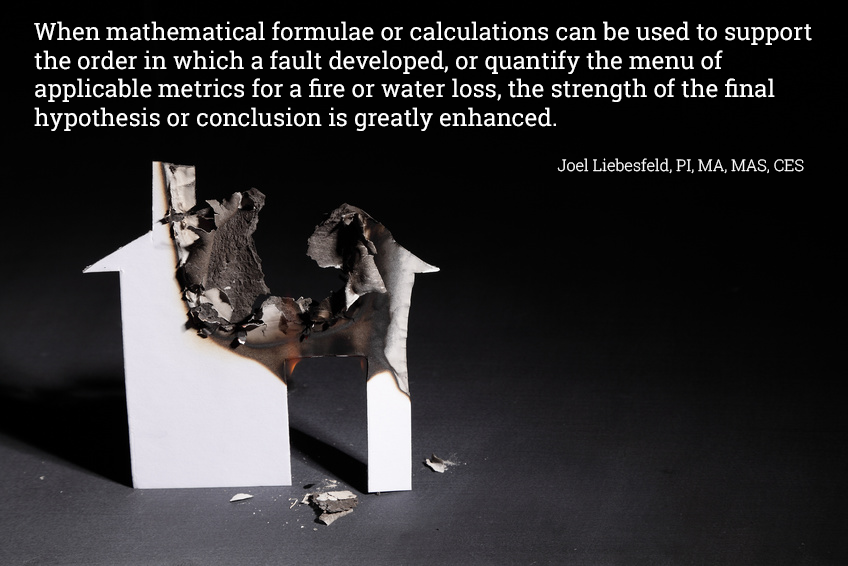Flash Sale
on past ISFI Proceedings (2004 – 2014)
All past electronic
(CD or Thumb Drive) editions
are just $25
July 11 – 15 ONLY

Flash Sale
on past ISFI Proceedings (2004 – 2014)
All past electronic
(CD or Thumb Drive) editions
are just $25
July 11 – 15 ONLY

Elizabeth C. Buc, PhD, PE, CFI
Fire and Materials Research Laboratory, LLC, USA
Presented at International Symposium on Fire Investigation, 2012
ABSTRACT
NFPA 921 Guide for Fire and Explosion Investigations recognizes the need for specialists for certain aspects of fire cause investigations. One such area is metallurgical failure analysis. Examples of metallurgical aspects that overlap the fire investigation field include vessel and pipeline failures from corrosion or welded joint failures causing loss of containment (i.e., natural gas); wear and mechanical breaks or failures that generate sparks or frictional heating that cause ignition; and elucidation of heat or fire versus electrical arc damage to current carrying components, such as conductors, motor windings, contacts, and fuses. Equally important, metallurgy can be used to determine the effects of fire on low-melting temperature alloys, such as brass and brazed joints, to determine when damage occurred and if it contributed to the cause of a fire or was a result of fire exposure. Like fire investigation, metallurgical root-cause failure analyses are performed according to a recognized professional standard methodology that meets the criteria for admissibility. Here, key elements of a metallurgical-based failure analysis are highlighted with specific metallurgical-based fire cause investigation case studies.

Meet a NAFI member: Brian Henry
Everyone at the National Association of Fire Investigators works hard to make sure our members reach their goals by supporting them with a variety of NFPA based trainings, certifications, and resources. When our members have the relevant education and resources that meet their needs, we’ve succeeded! We are proud of our team and are happy to share more about them with you.
Brian Henry is a Shareholder in the Sarasota, Florida office of Smith, Rolfes & Skavdahl Company, LPA. Brian is nationally-recognized for his knowledge and experience on expert preclusion issues, having written and lectured extensively on the subject and having handled more than 100 Daubert-type challenges in cases throughout the country. Brian has served as an expert witness on the standard of care for attorneys handling fire science cases, and he is a frequent lecturer on fire science, expert preclusion, and product liability issues at conferences throughout the country.
Brian and his wife Elizabeth have been married for 20 years and have two children, Sydney, 11, and Cooper, 9. They relocated to Lakewood Ranch, Florida, from Connecticut five years ago. Coincidentally, they thank Pat Kennedy with NAFI for their family’s relocation to Florida, as Pat invited Brian to speak at the NAFI Annual Conference in Sarasota several years in a row, and they fell in love with the area during those visits.
Brian will be speaking at ISFI 2016, you can get a preview of his presentation here.
How did you get started working with fire investigation/fire investigators?
I worked for a great attorney who handled fire cases for a major insurance carrier. The carrier was a large client of ours and it had its national fire science laboratory 20 minutes from the office. I had full access to all kinds of training and all of their experts, for free. I was fortunate to be able to attend all of their internal training sessions, ultimately obtaining over 1000 hours of fire investigation education through that client. I had full access to everything – an opportunity that most other attorneys would never have.
In my view, fire science litigation is a much more complex and complicated field of law than most insurance-related litigation. There is a level of scientific understanding that is required far beyond what is needed in “typical” cases. Many lawyers will tell you they have “handled” fire cases, but what they really have done is “parrot” what their expert witnesses have told them to say. When I began in the field, I was very uncomfortable with that – with not knowing whether my expert really knew what he or she was talking about. With the background I have in the field, I can have a substantive conversation with them about the evidence in the case. It becomes a true litigation partnership, which I think is essential.
I enjoy fire litigation because it’s more of a mystery or a puzzle than a regular case. My work starts from the moment of the claim — I get to be involved in solving the mystery from the outset. Many times I get calls while a fire is still burning, giving me the opportunity to be part of the initial fire scene investigation.
My involvement with NAFI goes back more than a decade. In the early 2000’s, I began attending NFPA 921 meetings, and I met Pat Kennedy at one of those meetings. From there, I joined NAFI and, ever since then, I have taught at NAFI’s Annual Conference, and I have taught a few times at ISFI. Several years ago, NAFI selected me as its General Counsel, and I am very proud to serve the organization in that fashion.
Why is NAFI an important organization for fire investigation?
I think the importance of NAFI is demonstrated through the sheer amount of educational opportunities offered to members and the general public. There are numerous conferences throughout the year, and the International Symposium on Fire Investigations is offered every other year. Any time you offer those kinds of high-quality forums to the public, that’s a good thing. I work with many, many fire investigators – some good, and some not so good. But the ones that a particularly dangerous are the ones who simply ignore the educational opportunities out there, and fail to keep up with the current state of fire science. Those folks don’t fare too well in depositions or at trial with me questioning them. NAFI provides crucial opportunities for people to develop their knowledge base in this very important field.
What is your favorite part of being involved with NAFI?
I really enjoy being part of an organization that is devoted to developing the quality of fire investigations. Both the programs offered throughout the year and the biennial Symposium really provide opportunities for high-level discussions on fire science issues. I am able to take what comes out of those events and use them in my practice.
What advice do you have for someone just starting out in your field/specialty with fire investigators?
They have to become educated in the subject matter. It is not enough to simply repeat or “parrot” what an expert witness tells you, or to robotically ask a pre-set list of questions. You have to understand the science; if you don’t, you’ll never be able to be an effective fire science litigator. I recommend that they work with an expert in the field and get onto the scenes and learn. I’ve probably investigated 150 to 200 fire scenes, actually getting my hands dirty and trying to determine the origin and cause of a fire. It makes a huge difference in understanding what you’re looking at in any given case, and how to approach future cases.
What advice do you have for existing NAFI members or fire investigators?
The learning process never ends. If you think you can’t learn something or be taught something, you’re a relic of the past. Every day there is a new development, somewhere in our field. I routinely see experts who think they can’t be taught something. Then, when they are at a deposition or on the witness stand, they figure out, quite unfortunately, that they were wrong. There are many tools that NAFI provides to help with training and continuing education.
What is your favorite book?
I’ve always liked the fantasy genre, so I would say The Lord of the Rings trilogy. My favorite author currently is Steve Berry, who writes great historical mystery fiction.
When you were a child, what did you want to do when you grew up?
Interestingly, for a brief period of time as a small child, I wanted to be a priest. That didn’t last too long, and then I got into history and learning about the Presidents. So, I decided I wanted to be President, and I learned that most of them had been attorneys, so I needed to be an attorney. I no longer have any desire to be in politics, but the intention to become an attorney stuck.
Fitting a Square Peg Into a Round Hole – Fire Classification Under NFPA 921
Brian P. Henry and Andrew L. Smith
This article will be presented at ISFI 2016
Introduction
This article will explore an important, but largely ignored, topic in NFPA 921 – should fire investigator experts classify fires? Does a classification of a fire as incendiary serve a purpose? Why did the NFPA implement authoritative guidelines permitting fire investigators the ability to separate fires into one of four distinctly defined categories? These important questions will be explored in detail below.
To begin, we must first ask ourselves why we investigate fires. As a society, we investigate a fire to find the root cause to prevent the fire from happening again. Public welfare and safety are huge concerns. Fire investigation implicates potential criminal responsibility. Some say the purpose of fire and explosion investigations is much broader than just determining the cause of a fire or explosion incident. The goal of any particular fire investigation is to come to a correct conclusion about the features of a particular fire or explosion incident that resulted in death, injury, damage, or other unwanted outcome.

Lim Beng Hui, M.Sc(FI)(Dist), B.Eng(Civil)(Hons), CFEI, CFII Singapore Civil Defence Force, Singapore
Yazeed Abdul Rahman, B.Eng(EEE)(Hons), CFEI, CVFI
Singapore Civil Defence Force, Singapore
Soh Seok Yuen, B.Eng(Mech)(Hons)
Singapore Civil Defence Force, Singapore
Presented at International Symposium on Fire Investigation, 2014
ABSTRACT
Air conditioning is common in Singapore households due to the hot and humid tropical weather all year round. The typical air conditioning found in Singapore homes is the multi-split system which comprises a condensing unit (CU) and a number of wall-mounted fan coil units (FCU). From 2008 to 2013, there were 168 reported multi-split air conditioning fires of which 74 involved the wall-mounted FCU.
Fires involving the wall-mounted FCU are of greater concern than fires involving other parts of the multi split system as they have the propensity to cause significant property damage. There is also a lack of awareness on such fires in some local communities.
This paper details the observations made in a study on fires involving the multi-split air conditioning system in Singapore from 2008 to 2013. The intent of this study is to present investigative evidence that wall-mounted FCU fires can happen. The study also seeks to debunk the myth that wall-mounted FCU fires cannot happen when the FCUs are on standby mode. Additionally, the study will discuss how the burn patterns can possibly mislead investigators and highlights the value in scrutinising fires which are localized to the wall-mounted FCU.
Alfonso Ibarreta, Ph.D., PE, CFEI, Timothy Myers, Ph.D., PE, CFEI, CFI, James Bucher, Ph.D., CFEI and Kevin Marr, Ph.D., CFEI Exponent, USA
Presented at International Symposium on Fire Investigation, 2012
ABSTRACT
Natural gas, composed mainly of methane, is in some ways similar to propane gas. Both fuels have similar energy densities per unit mass, and similar laminar premixed flame burning velocities. However, propane explosions have been shown to produce higher overpressures in unconfined explosion tests when compared to methane. In vapor cloud explosion modeling, methane is considered to be a “low” reactivity fuel, while propane is listed as a “medium” reactivity fuel. In closed vessel explosion testing, the maximum rate of pressure rise for propane is almost twice than that for methane (based on KG values reported in NFPA 68 (2007) Standard for Explosion Protection by Deflagration Venting , table E.1).
This study provides a direct comparison of the explosion severity between commercial propane and natural gas. Empirical correlations available for vented vessel explosions and unconfined Vapor Cloud Explosions (VCEs) are used to predict the difference in overpressure expected for a commercial propane explosion versus natural gas explosion. Although the maximum laminar burning velocity associated with propane is only about 15% higher than that associated with methane, commercial propane explosions are expected to result in overpressures that are about 40% higher than that of a natural gas explosion under identical conditions with a perfectly-mixed nearstoichiometric fuel-air mixture, based on empirical correlations.
In addition to the laminar burning velocity, other fundamental differences in the fuels may also play an important role in the explosion severity. Propane has a slightly higher expansion ratio than methane when undergoing combustion. The mass diffusivity of propane and methane are also quite different, making the premixed propane flame more prone to wrinkling under turbulent conditions. Future testing in the 20-L explosion chamber is suggested.

Investigative Bias Involving Smoke Alarms in Fatal Fires
Joseph M. Fleming, Deputy Chief
Vyto Babrauskas, Ph.D.
Presented at International Symposium of Fire Investigation, 2014
ABSTRACT
During the investigation of most fires, including fatal fires, the investigators focus almost all of their attention to the questions of cause and origin. This has been the traditional purpose of fire investigation. Because of this, the type of smoke detector involved, i.e. ionization or photoelectric, is seldom a factor that is considered important. In fact, in some cases little effort is made to determine if a smoke detector was even present. Complicating the investigation of this aspect of the fire is the fact that quite often the ceilings have been pulled down, along with the remains of the detector in an effort to extinguish the fire. The smoke detector, at least what is left of it, is buried in debris and difficult to recognize. In addition, the different factors that can affect a smoke detector’s ability to detect a fire in time to alert the occupants are not well understood. As a consequence, investigators are not aware of any reason to investigate the operation of the smoke detector.
In this paper we show why investigating aspects of smoke detector performance may be important, if not to address the cause and origin of the fire, at least to understand better the cause of injuries and fatalities. In doing this we endeavor to answer some questions that some investigators have had as to why some detectors may not have gone off in time to alert the occupants. In many cases investigators improperly assume that if the occupant did not escape, then this means that the smoke alarm did not operate. We also discuss the national statistic regarding smoke alarms and how the failure to collect relevant information may be leading to incomplete and misleading data analysis. Since Massachusetts started to collect this information and apply lessons learned to public education and code improvements, the fire death rate per capita has dropped much faster in Massachusetts, than in the US as a whole. While there may be many reasons for this, we are confident that better collection of data involving smoke alarms is a major factor.

SELECTED MATHEMATICAL NOTIONS TO COMPLEMENT FIRE/WATER SUBROGATION PROCESSING
Joel Liebesfeld, PI, MA, MAS, CES
James F. Valentine & Associates, Inc.
Presented at International Symposium of Fire Investigation, 2014
ABSTRACT
Making use of the scientific method means testing hypotheses until one final hypothesis survives that is durable enough to be sufficiently conclusive to meet the threshold of the standard of a reasonable degree of professional, scientific or engineering certainty. This paper is meant to elaborate on some common exemplar mathematical formulae and related information that, when applicable, can complement the expert reporting in subrogation losses. Proper insertion and reflection upon mathematically applicable formulae can add to the certainty of a report’s conclusion and the outcome in a subrogation proceeding.
The objective of the paper will be to turn the symbolism of mathematics into a language or a resource that can be used or extrapolated for testimony or reporting. The selected topics are those primarily seen or discussed in NFPA 921 and other fire and water related losses. In some instances the topical material presented will directly reflect on how the concepts are derived for applicable use in fire science/hydraulics. The topical material deploys mathematical notions derived from physics and chemistry that are the underlying sciences for most of the captioned losses.
Topics will include, but not be limited to, for example; detailed discussions about Heat Release Rates, Conduction, Heat Transfer, Air Flow and Ventilation, Water Flow, et al.
This paper is not intended to be a course in mathematics but rather intended to convey how specific mathematical values may be applicable, vary or can be affected by changing data related to certain nuances, such as ambient factors. These notions will be applied to selected mathematical principles that may be present in such situations as compartment or open fires, the treatment of fires, hydraulics, et al. Discussion may be extended to reflect on why certain constants are used and what they represent. Additionally, where appropriate, discussion will be reinforced by mathematical modeling. I have successfully used similar techniques when teaching adults in a university setting.